Shime saba is a cured mackerel fillet that is great for sashimi as well as sushi topping. It is very simple to make and so tasty. All you need is mackerel, salt and rice wine vinegar. If you can get a very fresh mackerel, simply cure the fillet and turn it into one of the best sushi toppings! No cooking, just marinating!
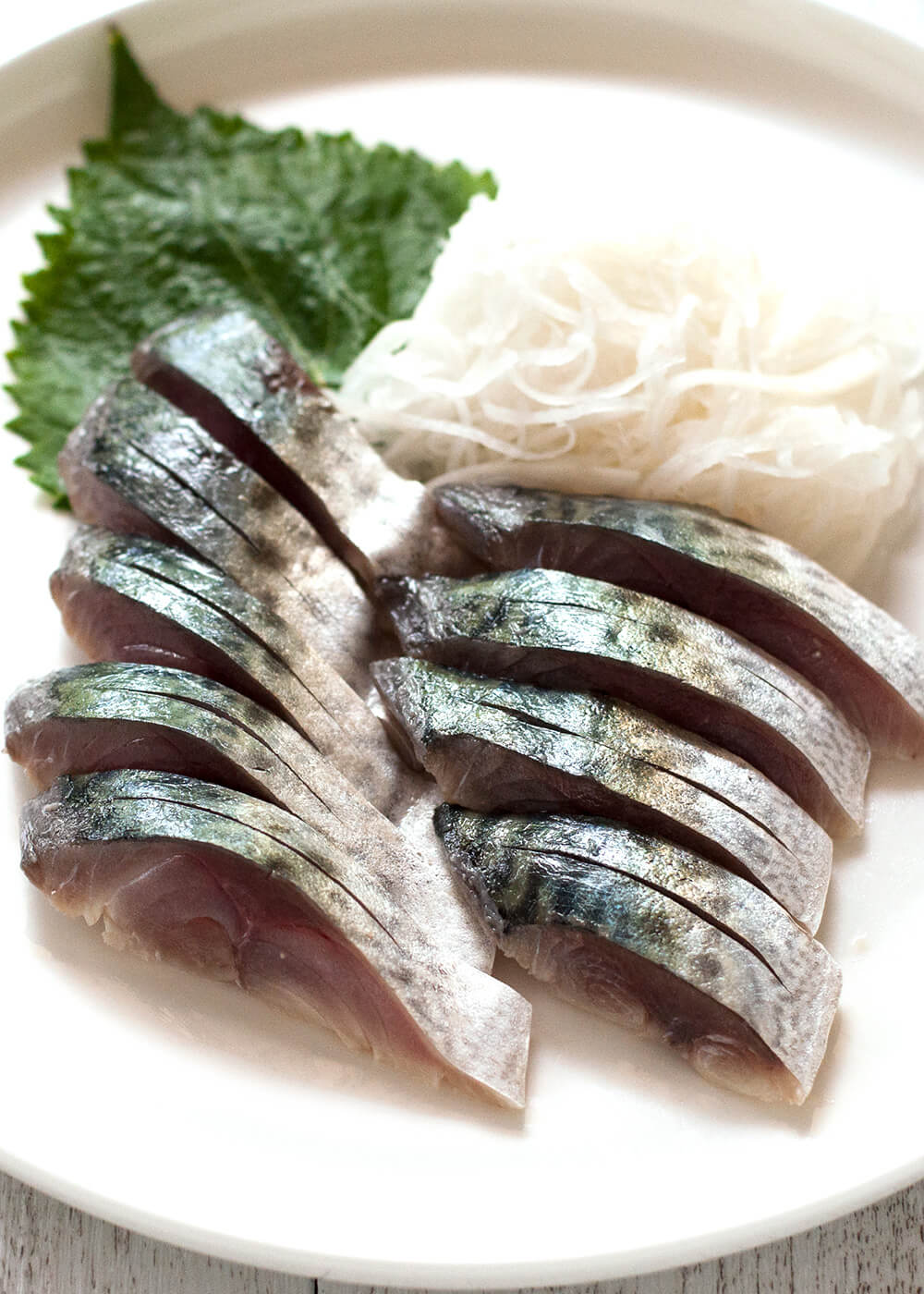
Shime saba (しめ鯖, cured mackerel) is one of my favourites for sushi or sashimi. Come to think of it, I am actually fond of any fish that has shiny skin and non-white flesh, such as mackerel, yellow tail, and sardines.
When I order sushi at the counter of a traditional sushi restaurant, I always end up ordering these fish as the toppings. Because of the shiny skin, they are collectively called hikarimono (shiny thing) at sushi shops. And they are the kind of fish that contain good amounts of omega-3 fats. They might not look as elegant as white-meat fish, but they are good for you and flavoursome.
Depending on the season and where the fish was caught, the amount of fat contained in mackerel varies. I love the oily mackerel that you can eat in autumn and winter in Japan. It is so tasty, even without curing. Mackerel grilled with just a bit of salt is divine when the fish is oily.
Unfortunately, the mackerel sold in Sydney is not as oily as that in Japan but it is still my favourite. When I see fresh mackerel at the fish shop, I get an urge to buy it even if I’ve just had some a couple of days ago. I don’t know what it is but I just love mackerel.
Mackerel is called saba (鯖) in Japanese and the word shime (しめ) comes from the verb shimeru (しめる) meaning firm up the flesh of the fish/meat. Hence, this dish is called “shime saba” (しめ鯖).
Mackerel is the kind of fish which goes bad very quickly. So it is important to use a very fresh mackerel and certainly buy a whole fish, not one already filleted. I always ask the fish shop how fresh it is and if I could have it as cured meat.
I am a regular customer at the nearby fish shop so they do me a favour and prepare the purchased fish, even if the fish was very cheap (mackerel is much cheaper than other white-meat fish or tuna!). So I usually ask them to fillet the whole mackerel so I have two sides of fillet with the skin on. But sometimes when they are busy, I fillet the fish myself.
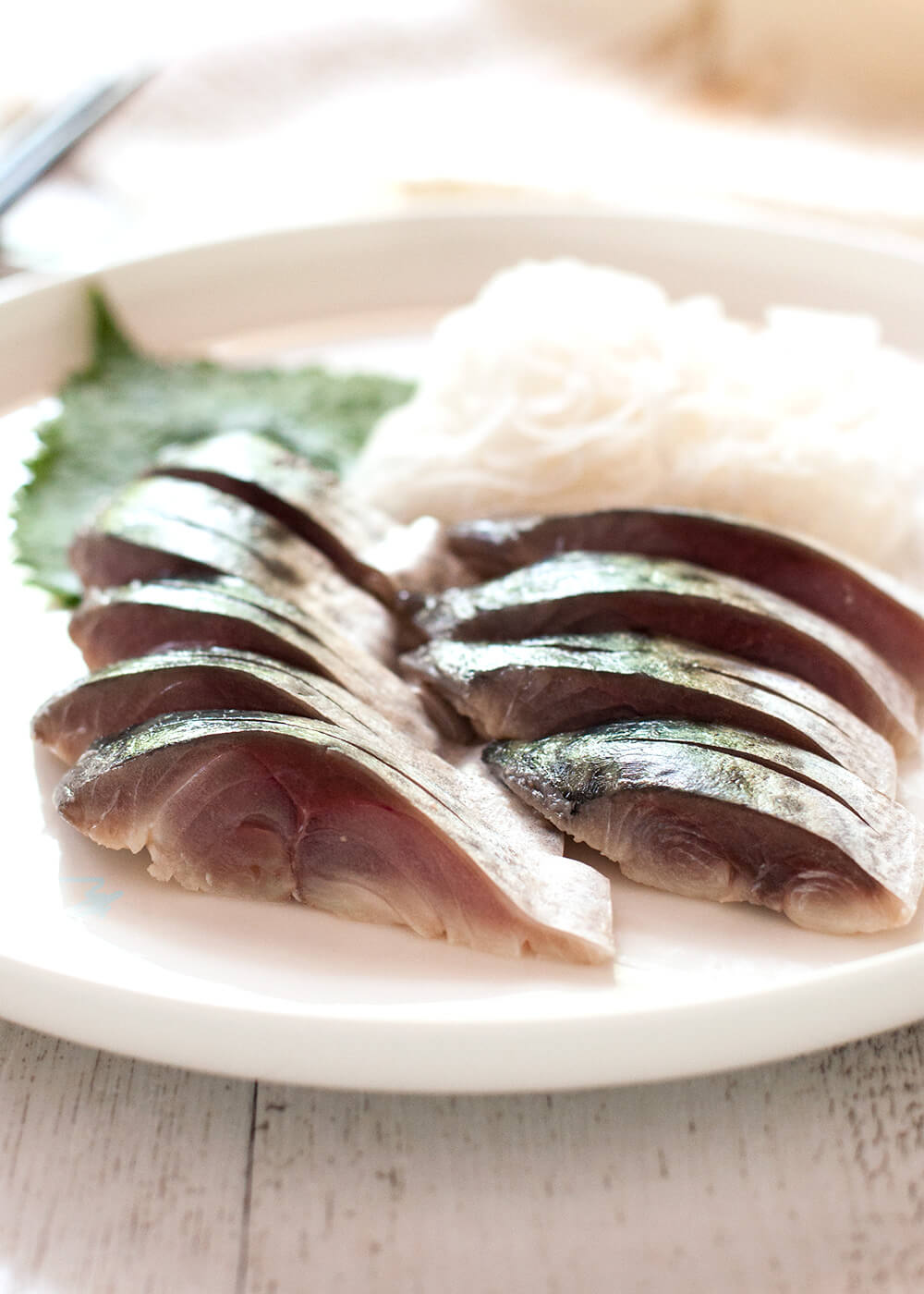 Filleting Mackerel
Filleting Mackerel
It is not very difficult to fillet mackerel as they have very soft bones.
- Chop the head off, cut the bottom of the belly and remove the guts.
- Run the knife down from the belly opening, towards the tail, along the back bone. Do the same on the dorsal side.
- Then push the tip of the knife through at the tail end of the meat, with the blade facing to the tail. Slide towards the tail but do not cut through so that the meat is intact at the tail end.
- Holding the tail, place the knife into the tail end slit, facing the blade to the head. Slide the knife along the back bone towards the head to make one side of fillet.
- Turn the fish over and repeat steps 2 – 4.
- Remove the rib cage by thinly slicing diagonally.
Importance of Covering the Fillets with Salt
Before marinating the fillets in rice wine vinegar, the fillets need to be covered with a generous amount of salt for about 1 hour. There are reasons for this:
- Add salty flavour
- Firm up the flesh
- Remove the fishy smell
As you can see in the step-by-step photo at the end of the recipe, quite a generous amount of salt is sprinkled over the fish.
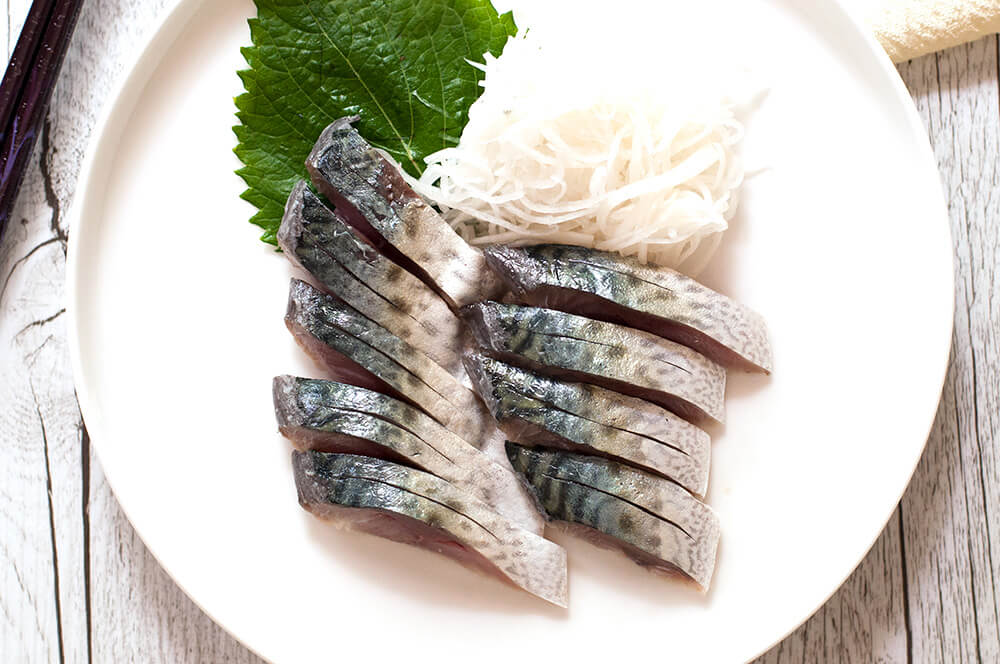 Marinating in Vinegar
Marinating in Vinegar
There are different versions of marinade for shime saba. The simplest marinade is just rice wine vinegar. I like this version and today’s recipe is this simple one. But if you like a slightly sweet flavour, you could add some sugar to it. Some recipes add a small piece of konbu (kelp).
It is all up to you and you can experiment to find the flavour that is best for you. It is such an easy way of preparing raw fish and is perfect for fish like mackerel.
The duration of marinating the fillets also varies and it depends on your liking. The minimum length of time is 15 minutes and the longest one I found on the Japanese recipe site was ½ a day. I marinate mine for a couple of hours. The more you marinate, the firmer the flesh becomes, and the colour of the flesh turns white as the vinegar penetrates into the flesh.
The duration of marinating and how far the flesh changes colour depends on the size of the fish.
Preparing for Sashimi/Sushi
You will need to remove the tiny bones which run where the back bone was. Then peel the thin skin off. It should be quite easy to peel the skin off once the fillets are marinated.
I slice the fillet differently depending on the purpose. If shime saba is for temakizushi (hand rolled sushi), which I will be posting soon, I slice the fillet almost straight down at a narrow width so that the fish can be easily rolled. See the photos below.
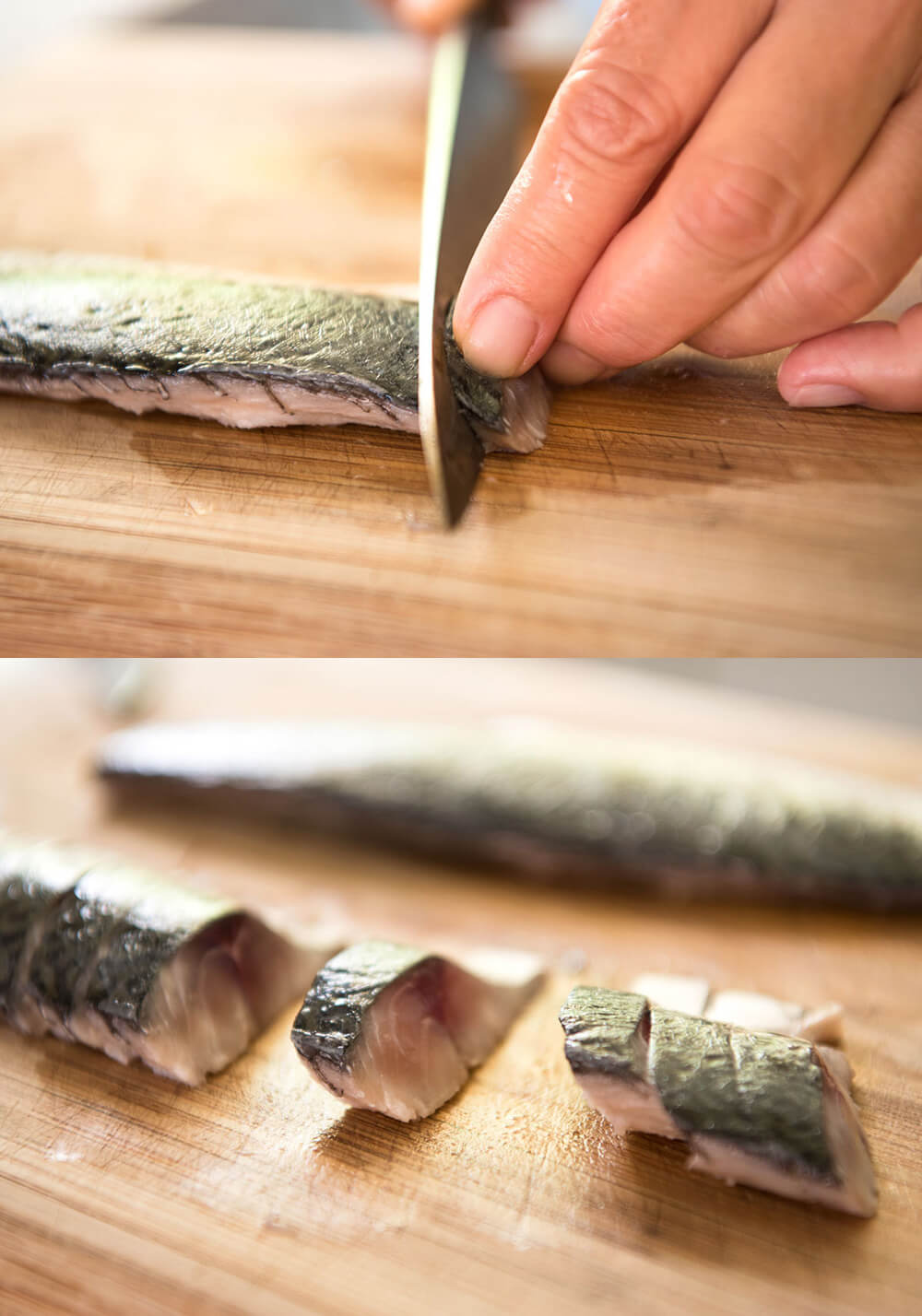
But if it is to be used for nigirizushi, I will slice the fillet diagonally with the knife tilted 45 degrees or more so that the sliced piece has a thin wide shape which is suitable to be placed on top of the rice ball.
When served as sashimi, like in the first photo, I usually slice either diagonally and not as wide as the sushi version, or slice like the temakizushi piece but wider. And I make a shallow incision on the skin in the centre of each slice.
There is a reason why I add a shallow slice in the middle when making sashimi. Because shime saba is made with the shiny skin on, it tends to repel soy sauce when dipped into it. By having an incision, it catches more soy sauce. Very thoughtful, don’t you agree?
As you can see in the recipe, there is no fixed amount of ingredients to make shime saba because it depends on the size of the fish, the size of the tray, and your preference. If you think about it, this is such a forgiving recipe. I hope you try shime saba.
Yumiko![]()
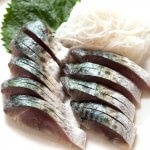
- Very fresh mackerel - cleaned and filleted with skin on (note 1)
- Salt - enough to cover both sides of fillet generously (note 2)
- Rice Wine Vinegar - enough to cover the fillet in a container/tray (note 3)
- Shredded daikon (white radish)
- Shiso (parella) leaves
-
Coat each fillet with generous amount of salt so that the entire surface of both skin side and flesh side are covered.
-
Place the fillets on a plate/tray ensuring that one side of the plate/tray is raised, so that the moisture extracted from the fillets will b collected on one side and does not soak the fillets (note 4). Leave it for 1 hour in the fridge.
-
Fill a bowl with water. Rinse the fillet gently in the bowl and pat dry with paper towel.
-
Place the fillets in a tray or a deep flat bottomed plate, add rice wine vinegar so that it almost covers the fillet. Leave for 2 hours in the fridge (note 5).
-
Place the fillet skin side down. Using a pair of tweezers, remove the small bones where the backbone was. If you run your finger along the centre of the fillet, you should feel the bones. (note 6)
-
Turn the fillet over and place it skin side up, pointing the tail end to the right (I am a right hander).
-
Starting from the tip of the head side of the fillet, which is on the left, pinch the corner of the very thin, semi-transparent skin and lift it up to start peeling.
-
Peel the skin towards the tail and remove the entire skin (note 7). As you peel the skin, hold the fillet on the head side with your left hand so that the fillet will not move.
-
Slice the fillet 1cm (⅜”) thick if you are serving it as part of temakizushi. If serving as sashimi, slice them 1.5cm (⅝”) thick and make a shallow incision in the middle on the skin. If using it as nigirizushi topping, slice it diagonally so that the width of the mackerel is about 3cm (1⅛”).
1. The two fillets I used were about 180g (6.3oz) in total.
2. I used about 19g (0.7oz) of salt to cover the two fillets.
3. This will entirely depend on the size of the container. A container/tray that just fits in two fillets would be most economical. I used about 250ml of vinegar to cover the fillets.
You could also use a zip lock plastic bag but I find that the vinegar will not penetrate evenly unless you can make the vinegar cover all of the fillet in some way.
4. I have a round steaming basket and I can adjust the diameter by opening and closing it. When fully opened, it becomes almost flat. So I use this basket placed on a plate to catch dripping from the fish as the moisture is extracted. Either way works fine.
5. Marinating time for the fillets depends on the size of the fillets, freshness of the fish and your preference of how much you want the fish to be cured.
The shortest time I found on the website is 15 minutes. This is almost like sashimi with a touch of vinegar flavour around the fillets. This is suitable only if the fish is extremely fresh. Some recipes leave it for 3 hours.
Marinating too long will make the entire flesh turn white which does not look appetising in my view.
6. The bones along the backbone are attached diagonal to the body of the fish. When removing the tiny bones, pull them in the direction of the bones so that they will not damage the flesh when pulled out.
7. When peeling the skin around the belly, try to pull the skin towards the belly, instead of towards the tail. Because the meat is very thin, it tends to break and go with the skin if you pull towards the tail. Once the skin in the belly area is peeled, then you can easily peel off the rest.
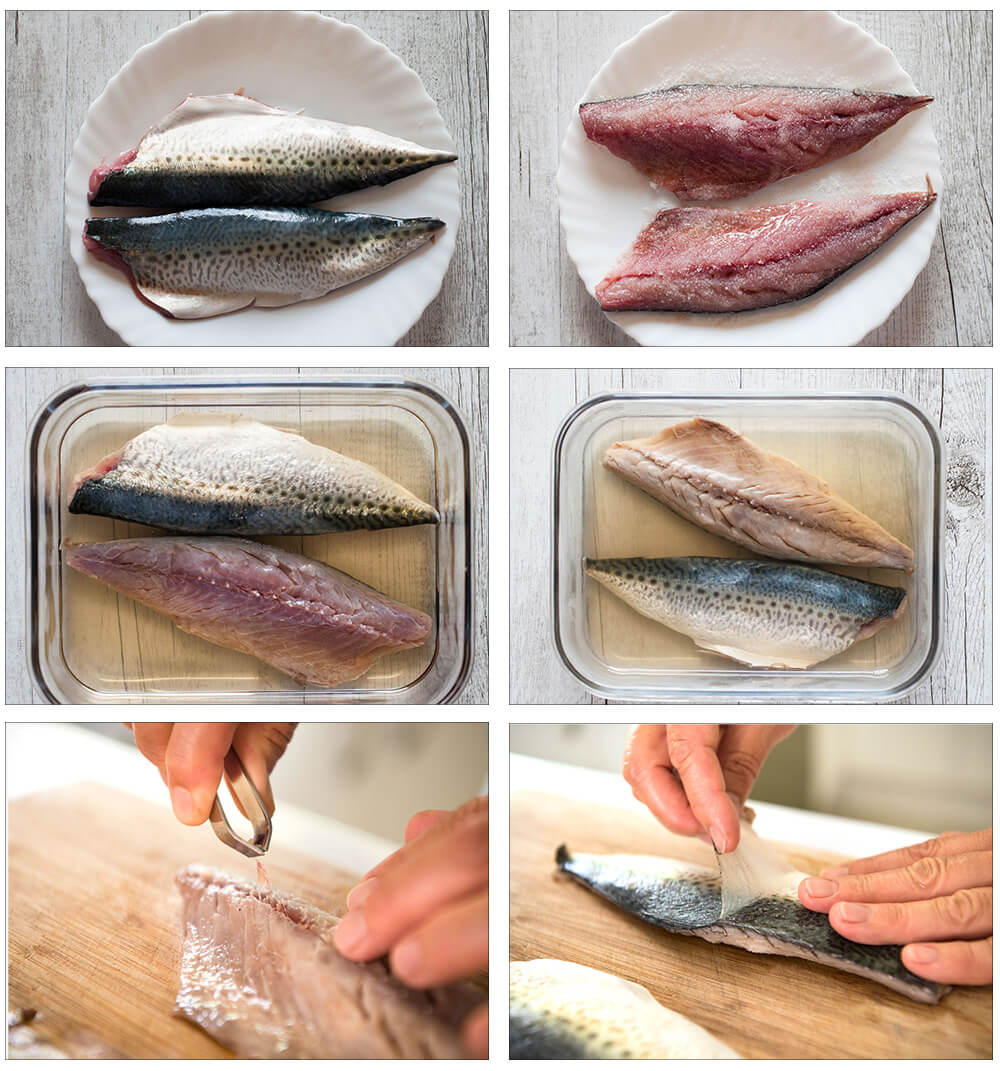
thank you so much for your recipes! I live in a small town on the coast of Washington State, USA, and we don’t have a good sushi restaurant. Saba is my favorite, and now I can make it at home, tastes amazing, and very affordable!
Hi Olia, Saba is my favourite too. You are right about affordability. I like it better than expensive white flesh fish such as snapper.
Hi from Japan.
What is that special character mark for ShimeSaba? It is a simple mark possibly used as Shimeru in a bill of laden?
Thanks
The letter 〆 or 乄 that is often used for the word shime saba, i.e. 〆さば or 〆鯖 instead of しめさば or しめ鯖, means close or tighten. In the case of shome saba, the fresh is tightened by curing, hence 〆鯖. Some people put this letter on the back of the sealed envelope indicating that the envelope is closed.
Just passed midnight here in London. Bought super fresh mackerel yesterday from billinggate market. Followed the recipe to the T. Absolutely delicious. P.s
Peeling of the translucent skin was extremely satisfying. Will be much more gentle next time as beautiful mackerel pattern came away slightly with the peel. Regardless, I’ve just had a cheeky slice and mouth is dancing. Arigato’
Hi Obi, you are most welcome!
Mackerel caught in cold winter must be so delicious with good amount of oil in the flesh, which I cannot get in Sydney. I envy you. You are right about peeling of the skin. It bring me a smile, especially when the skin came off neatly.
Hi Yumiko! This recipe looks amazing! Just wondering if different Vinegars could be used in place of Rice Wine? Thanks so much!
Hi Catie, use apple cider vinegar if you can. Standard distilled vinegar could be too sharp in acidity. I love Shime Saba. I hope you like it too.
Nice recipe, thanks. If the mackerel isn’t going to be used for a few days, should the vinegar be rinsed off and the fish patted dry? Can the vinegared mackerel be frozen for later use?
Hi Tom, yes, you don’t rinse the marinated fillet with running water but just pat-dry the fillet. You can keep them no more than a few days in the fridge. Alternatively, freeze pat-dried fillet after wrapping it in cling wrap. Thaw it in the fridge.
I have never frozen the vinegar after use. But the vinegar can be reused so I can;t see why you cannot freeze it for the 2nd round.
Excellent website – a pleasure to follow the perfect recipe . . interesting notes by readers
Thank you very much, Ingo.
Hi Yumiko
I live in Brisbane. I would love to try this recipe. My question is can I just buy Mackerel from the local seafood market or it has to be specific one for sushi quality? Thank you so much.
Hi Sam, the local fish shop probably do not sell mackerell as sushi quality. I buy mackerel at the local fish shop but I use it only if the fish is caught in the morning and very fresh.
You need to remove the skin membrane with mackerel, it harbours bacteria. Lay it skin side down and cut through at the tail end almost through the skin, scraping it till you get to the membrane.
Flip it over, now lift the clear, plastic like membrane off the filet, scraping it if it starts to pick up the actual skin.
Then marinate it, it is now safe to eat.
Hi Matthew, the mackerel I know does not seem to have membrane that can be peeled off the skin. MAybe your mackerel is slightly different species. The Japanese method of making vinegar cured mackerel does not certainly attempt to remove it. Curing with plenty of salt before marinating in vinegar certainly attempts to kill bacteria, in addition to firming up the flesh.
Thanks for this. I’m from the highlands of Scotland and we catch a lot of mackerel here in the summer months. We bbq it, smoke it, give to friends and neighbours but we are yet to try it as sashimi, which is crazy because we make and eat a lot of sushi (it’s the kids favorite food and can’t be bought locally). We buy in the nori, Mizkan Sushi Seasoning and Shinmei Koshihikari rice, and even though I have had Shime saba in the past I have never thought to try and make it… Until now 🙂 Thanks!
Hi Tim, unlike the mackerel in Australia, Scottish mackerel must be oily and plump. How lucky you are!
They are beautifully oily.. I think the cold water of the North Sea helps. I caught 29 last night from the pier in Cromarty (should you wish to Google) which is enough for the freezer and the neighbours.. and Shime saba!
Hi Tim, I know you are in Scotland. I can imagine the oil coming out of the mackerel when you grill it with a bit of salt, just like the one you get in Japan. Yum!
You can also semi-dry butterflied mackerel. After butterflying, put them through the salt water (the salt% to be similar to the sea water), then dry in the sun. You can then freeze if too many. Grilled semi-dried fish gives you a different texture and flavour.
Rather than Vinegar, I’d rathr use Lemon Juice. How different does it change the taste?
Hi Elinor, you can use lemon juice instead of vinegar. The flavour will be naturally different as you will taste lemon. You might find it more refreshing.
Hello, Before I try this recipe, I was wondering if you have a photo or instructions for how to add konbu to the recipe? And a photo of the presentation?
Thank you!
Jacques
Hi Jacques, this post was published 5 years ago. At the time, I did not think of showing a step-by-step photo. Sorry about that. Next time when I find a fresh mackerel (hopefully soon), i will make Shime Saba and update the post with more photos.
Hi Jacques, I have to revert back my previous reply. I thought I missed the basic step-by-step photos in the post. But there is a photo at the end of the recipe.
to add konbu, just cut a couple of 10cm / 4″ square konbu, put them in the vinegar with the fish fillet. The konbu will not t served with the fish.
Do you know if Spanish or Cero Mackerel from the Gulf of Mexico can be used?
Hi Marty, yes you can if the fish is very fresh and not very large, say no more than 40cm / 1.3ft long.
Hi, I have some whole frozen mackerel (doesnt have anymore description than that) that i bought from a seafood store, would this fish be acceptable to use for this recipe?
Hi Annika, unless it is labelled as sashimi quality, I would not use it, unfortunately. Instead of mackerel, you could use a fish such as horse mackerel/yellowtail or similar (if they are very fresh). I hope you can find something as alternate.
Can I use a frozen horse mackerel for this recipe ?
It’s available in my country
Hi Sheila, if the mackerel is very fresh, it can be done. When thawed, check the guts to see if they are disintegrated or not, if disintegrated, the fish was not very fresh when frozen. If fish was frozen quickly immediately after being caught, it should look very fresh when thawed. To be safe, I would cure longer than 2 hours so that the most part of fresh becomes whitish.